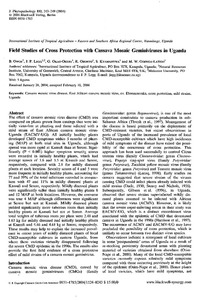| dc.contributor.author | Owor, B. |
| dc.contributor.author | Legg, J.P. |
| dc.contributor.author | Okao‐Okuja, G. |
| dc.contributor.author | Obonyo, R. |
| dc.contributor.author | Kyamanywa, S. |
| dc.contributor.author | Ogenga‐Latigo, M.W. |
| dc.date.accessioned | 2019-12-04T11:23:55Z |
| dc.date.available | 2019-12-04T11:23:55Z |
| dc.date.issued | 2004-04 |
| dc.identifier.citation | Owor, B., Legg, J.P., Okao‐Okuja, G., Obonyo, R., Kyamanywa, S. & Ogenga‐Latigo, M.W. (2004). Field studies of cross protection with cassava mosaic geminiviruses in Uganda. Journal of Phytopathology, 152(4), 243-249. |
| dc.identifier.issn | 1439-0434 |
| dc.identifier.uri | https://hdl.handle.net/20.500.12478/4209 |
| dc.description.abstract | The effect of cassava mosaic virus disease (CMD) was compared on plants grown from cuttings that were initially virus-free at planting and those infected with a mild strain of East African cassava mosaic virus-Uganda (EACMV-UG). All initially healthy plants developed CMD symptoms within 5 months of planting (MAP) at both trial sites in Uganda, although spread was more rapid at Kamuli than at Serere. Significantly (P < 0.001) higher symptom severity scores were recorded in initially healthy plants, which had average scores of 3.6 and 3.5 at Kamuli and Serere, respectively, compared with 2.8 for mildly diseased plants at each location. Severity scores of 4 and 5 were more frequent in initially healthy plants, accounting for 77 and 39% of the total infections recorded in comparison with 47 and 11% in mildly diseased plants at Kamuli and Serere, respectively. Mildly diseased plants were significantly taller than initially healthy plants 8 and 12 MAP at both locations. However, the converse was true 4 MAP although differences were significant at Serere but not at Kamuli. Mildly diseased plants yielded significantly more tuberous roots than initially healthy plants at Kamuli but not at Serere. Average total weights of tuberous roots per plant were 2.48 and 1.63 kg for mildly diseased and initially healthy plants at Kamuli and 4.46 and 4.61 kg at Serere, respectively. These results may help to explain the increased prevalence in recent years of mildly diseased plants of local CMD-susceptible cultivars in eastern Uganda, from where these varieties virtually disappeared following the severe CMD epidemic in the 1990s. The results also provide the first field evidence of a cross protective effect of mild strains of a cassava mosaic geminivirus. |
| dc.description.sponsorship | Rockefeller Foundation |
| dc.language.iso | en |
| dc.subject | Cassava |
| dc.subject | African Cassava Mosaic Virus |
| dc.subject | Plant Diseases |
| dc.subject | Begomovirus |
| dc.title | Field studies of cross protection with cassava Mosaic Geminiviruses in Uganda |
| dc.type | Journal Article |
| dc.type | Journal Article |
| dc.description.version | Peer Review |
| cg.contributor.crp | Roots, Tubers and Bananas |
| cg.contributor.affiliation | International Institute of Tropical Agriculture |
| cg.contributor.affiliation | University of Greenwich |
| cg.contributor.affiliation | Makerere University |
| cg.coverage.region | Africa |
| cg.coverage.region | East Africa |
| cg.coverage.country | Uganda |
| cg.isijournal | ISI Journal |
| cg.authorship.types | CGIAR and developing country institute |
| cg.iitasubject | Cassava |
| cg.iitasubject | Plant Diseases |
| cg.accessibilitystatus | Limited Access |
| local.dspaceid | 99775 |
| cg.identifier.doi | https://doi.org/10.1111/j.1439-0434.2004.00837.x |

